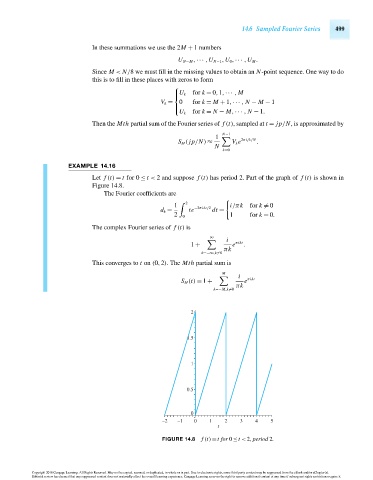Page 519 - Advanced engineering mathematics
P. 519
14.6 Sampled Fourier Series 499
In these summations we use the 2M + 1 numbers
U N−M ,··· ,U N−1 ,U 0 ,··· ,U M .
Since M < N/8 we must fill in the missing values to obtain an N-point sequence. One way to do
this is to fill in these places with zeros to form
⎧
for k = 0,1,··· , M
⎪U k
⎨
V k = 0 for k = M + 1,··· , N − M − 1
⎪
for k = N − M,··· , N − 1.
⎩
U k
Then the Mth partial sum of the Fourier series of f (t), sampled at t = jp/N, is approximated by
N−1
1
S M ( jp/N) ≈ V k e 2πijk/N .
N
k=0
EXAMPLE 14.16
Let f (t) = t for 0 ≤ t < 2 and suppose f (t) has period 2. Part of the graph of f (t) is shown in
Figure 14.8.
The Fourier coefficients are
2
1 −2πikt/2 i/πk for k = 0
d k = te dt =
2 0 1 for k = 0.
The complex Fourier series of f (t) is
∞
i
πikt
1 + e .
πk
k=−∞,k =0
This converges to t on (0,2).The Mth partial sum is
M
i πikt
S M (t) = 1 + e
πk
k=−M,k =0
2
1.5
1
0.5
0
–2 –1 0 1 2 3 4 5
t
FIGURE 14.8 f (t) = tfor 0 ≤ t < 2, period 2.
Copyright 2010 Cengage Learning. All Rights Reserved. May not be copied, scanned, or duplicated, in whole or in part. Due to electronic rights, some third party content may be suppressed from the eBook and/or eChapter(s).
Editorial review has deemed that any suppressed content does not materially affect the overall learning experience. Cengage Learning reserves the right to remove additional content at any time if subsequent rights restrictions require it.
October 14, 2010 16:43 THM/NEIL Page-499 27410_14_ch14_p465-504

